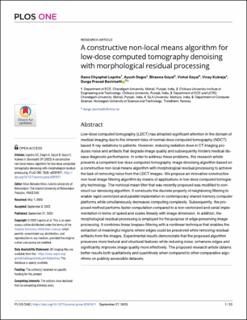| dc.contributor.author | Lepcha, Dawa Chyophel | |
| dc.contributor.author | Dogra, Ayush | |
| dc.contributor.author | Goyal, Bhawna | |
| dc.contributor.author | Goyal, Vishal | |
| dc.contributor.author | Kukreja, Vinay | |
| dc.contributor.author | Bavirisetti, Durga Prasad | |
| dc.date.accessioned | 2024-01-25T14:45:24Z | |
| dc.date.available | 2024-01-25T14:45:24Z | |
| dc.date.created | 2023-10-20T13:23:11Z | |
| dc.date.issued | 2023 | |
| dc.identifier.citation | PLOS ONE. 2023, 18 (9), . | en_US |
| dc.identifier.issn | 1932-6203 | |
| dc.identifier.uri | https://hdl.handle.net/11250/3113931 | |
| dc.description.abstract | Low-dose computed tomography (LDCT) has attracted significant attention in the domain of medical imaging due to the inherent risks of normal-dose computed tomography (NDCT) based X-ray radiations to patients. However, reducing radiation dose in CT imaging produces noise and artifacts that degrade image quality and subsequently hinders medical disease diagnostic performance. In order to address these problems, this research article presents a competent low-dose computed tomography image denoising algorithm based on a constructive non-local means algorithm with morphological residual processing to achieve the task of removing noise from the LDCT images. We propose an innovative constructive non-local image filtering algorithm by means of applications in low-dose computed tomography technology. The nonlocal mean filter that was recently proposed was modified to construct our denoising algorithm. It constructs the discrete property of neighboring filtering to enable rapid vectorized and parallel implantation in contemporary shared memory computer platforms while simultaneously decreases computing complexity. Subsequently, the proposed method performs faster computation compared to a non-vectorized and serial implementation in terms of speed and scales linearly with image dimension. In addition, the morphological residual processing is employed for the purpose of edge-preserving image processing. It combines linear lowpass filtering with a nonlinear technique that enables the extraction of meaningful regions where edges could be preserved while removing residual artifacts from the images. Experimental results demonstrate that the proposed algorithm preserves more textural and structural features while reducing noise, enhances edges and significantly improves image quality more effectively. The proposed research article obtains better results both qualitatively and quantitively when compared to other comparative algorithms on publicly accessible datasets. | en_US |
| dc.language.iso | eng | en_US |
| dc.publisher | Public Library of Science | en_US |
| dc.rights | Navngivelse 4.0 Internasjonal | * |
| dc.rights.uri | http://creativecommons.org/licenses/by/4.0/deed.no | * |
| dc.title | A constructive non-local means algorithm for low-dose computed tomography denoising with morphological residual processing | en_US |
| dc.title.alternative | A constructive non-local means algorithm for low-dose computed tomography denoising with morphological residual processing | en_US |
| dc.type | Peer reviewed | en_US |
| dc.type | Journal article | en_US |
| dc.description.version | publishedVersion | en_US |
| dc.source.pagenumber | 0 | en_US |
| dc.source.volume | 18 | en_US |
| dc.source.journal | PLOS ONE | en_US |
| dc.source.issue | 9 | en_US |
| dc.identifier.doi | 10.1371/journal.pone.0291911 | |
| dc.identifier.cristin | 2186790 | |
| cristin.ispublished | true | |
| cristin.fulltext | original | |
| cristin.qualitycode | 1 | |

